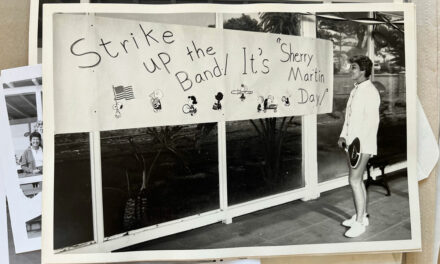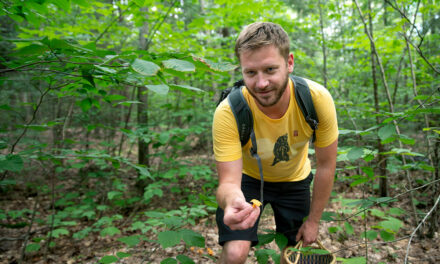
A Perfectly Plated Life
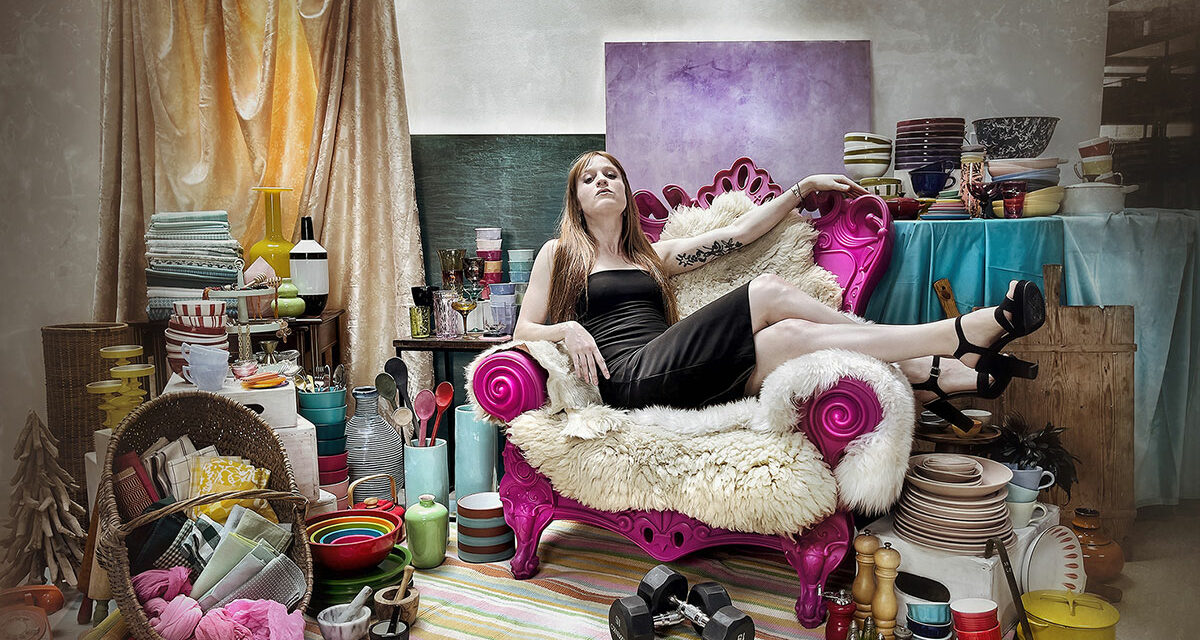
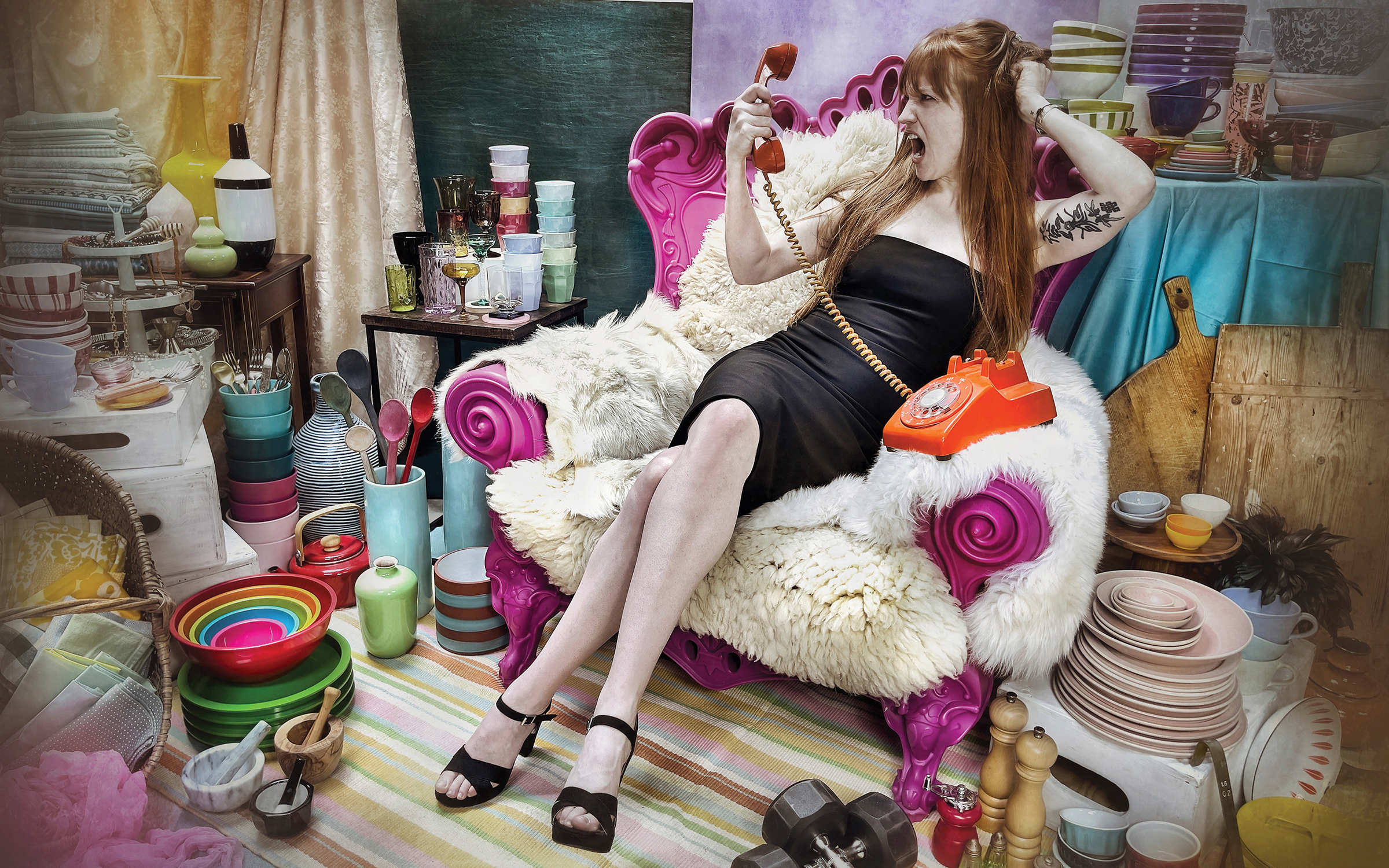
A Perfectly Plated Life
Courtenay Philbrick ‘07 loves pretty things
ARTICLE BY JESSICA YARMOSKY
PHOTOS BY KEITH BARRACLOUGH
If you’re a fan of cookbooks or food magazines, you’ve probably spent hours staring at lush-looking photographs of flaky pastries, juicy meat, or vegetables roasted to perfection. These photos make us feel things, just as they’re designed to. But look closer—beyond the food—and you’ll notice that each lavish picture contains multitudes. From the dishes holding the food, to the silverware set perfectly next to it, to the surface on which the dishes are sitting—these props aren’t picked at random. Instead, they’re carefully curated to evoke certain emotions in readers, to deliver on a complex and artistic vision.
And when they’re not being used in photo shoots, there’s a chance those props live on the shelves of Plate & Patina, a prop house owned by Courtenay Philbrick.
If, like me, you’re new to the entire concept of prop houses, Courtenay explains it simply. “We’re kind of like a library,” she says. But instead of books, Courtenay’s collection includes over thirty-thousand pieces, from vases and plates, to glassware and cutting boards, to mixing bowls and linens. They’re not used exclusively for food photo shoots, either – stylists will rent pieces for product shoots and other branded content. Some pieces are vintage, some are contemporary. Some are made explicitly for Plate & Patina, and some end up in the prop house in more organic ways.
“I didn’t realize this would happen as much as it does,” Courtenay laughs. “But people will reach out to me, and they’ll have a collection of things that they inherited from their grandmother…and they’ll offer it up to me for purchase, to use as props.”
Courtenay oversees both her flock of items and five employees. “My job as the owner of the business is to acquire new props, oversee the checking in and checking out of everything, and make sure things run smoothly,” she says. An operations manager acts as a second in command, and oversees the day-to-day exchanges at the prop house. And three part-time employees help pack items for orders, clean items that have been returned, and organize shelves.
Sourcing props is a big part of Courtenay’s job. She’s not looking for mass-manufactured dishware from, say, the local big box store. “We have specialty items,” she explains. “So it’s harder to source them. It takes longer.”
Sometimes sourcing looks like traveling to antique fairs and auctions out of state, and sometimes that just means scrolling endlessly through Etsy, connecting with makers. One of Plate & Patina’s specialties is handmade ceramics, which Courtenay sources from all over the world. Ceramic artists will sometimes work with Courtenay to make pieces specifically for the prop house.
Managing a prop house means staying on top of trends, no matter how fleeting. Each photo shoot has a specific air that stylists want to capture, and props are a major part of that. “You never know what people are going to want,” Courtenay explains. “It’s very unpredictable, so it’s in our best interest to have the widest variety possible of all different genres and styles. We had someone come in, and they were like, ‘We need trays that feel like they’re from the nineties.‘”
Courtenay delivered.
The organization of pretty things
Courtenay herself will be the first to tell you about her Type A personality. Which makes sense, given the expansive collection of props she manages.
“This is the perfect, structured job for me,” she laughs. “I love organization, especially organization of pretty things.”
Plate & Patina is open for business Monday through Friday. Courtenay starts each workday by meeting with her operations manager, Marion Mason. “We’re seeing what orders need to go out, taking inventory of things that have just come back, and getting a feel for what the day’s going to be like,” she says. She spends a significant portion of each day going over inventory, adding items to the company’s database, or fixing bugs in their computer system. She also makes herself available to stylists who come in to peruse the props. “Some people want help when they’re pulling stuff for their orders,” she says. “And some people want to be left alone.”
When there’s downtime, Courtenay and Marion turn to marketing. They’ll set up mini photo shoots in the warehouse to post on the company Instagram, or create Reels to showcase some of their props. Sometimes, stylists and photographers will come in and use the space for their own product shoots. Depending on what customers want, each day looks different.
But for Courtenay, each day is fulfilling. After working as a stylist’s assistant, she’s found her niche. Plate & Patina “has put together my love of working in the creative industry, but not necessarily being the person creating the content,” she explains. “I think the pressure of being a stylist didn’t really work for me. But I like being the one that creates the infrastructure for those people to do what they do.”
Courtney’s hard-to-miss creative streak and desire to help others bring their visions to life makes her and her work seem like a match made in heaven. But her path to owning a prop house certainly wasn’t linear, nor did she ever imagine this line of work for herself. Like many fateful partnerships, she “kind of fell into it accidentally.”
“I found my own”
In 1994, Courtenay arrived at SSSAS as a kindergartner. She’d spend the next twelve years honing her skills as a student and an actor. “The drama department was my home away from home,” she says, and this was especially true as she entered high school. “It was a really special time for me. I found my own within that department.”
She has fond memories of her favorite teacher, Jim Marvin who was “such a wonderful person. He really helped me throughout high school.” In Courtenay’s junior year, Mr. Marvin was injured while building a set and spent some time in the hospital. His students and colleagues rallied around him. Another teacher took over directing the spring musical, and because, as Courtenay laughs, “I won’t sing and dance on stage,” she was asked to co-direct. That role helped her flex her leadership muscles, and—like she does every day now—honed the skills she needed to take something from a vision to reality.
By Courtenay’s senior year, Mr. Marvin had recovered from his injury and was back, directing the play “You Can’t Take It With You.” Courtenay counts being part of that ensemble cast as one of her fondest memories as a Saint. “It was such a wonderful group of people,” she says. “We had a couple of athletes, that weren’t normally taking part in things like this…There was an electricity to it that was really, really special. We could tell that Mr. Marvin was just so proud.”
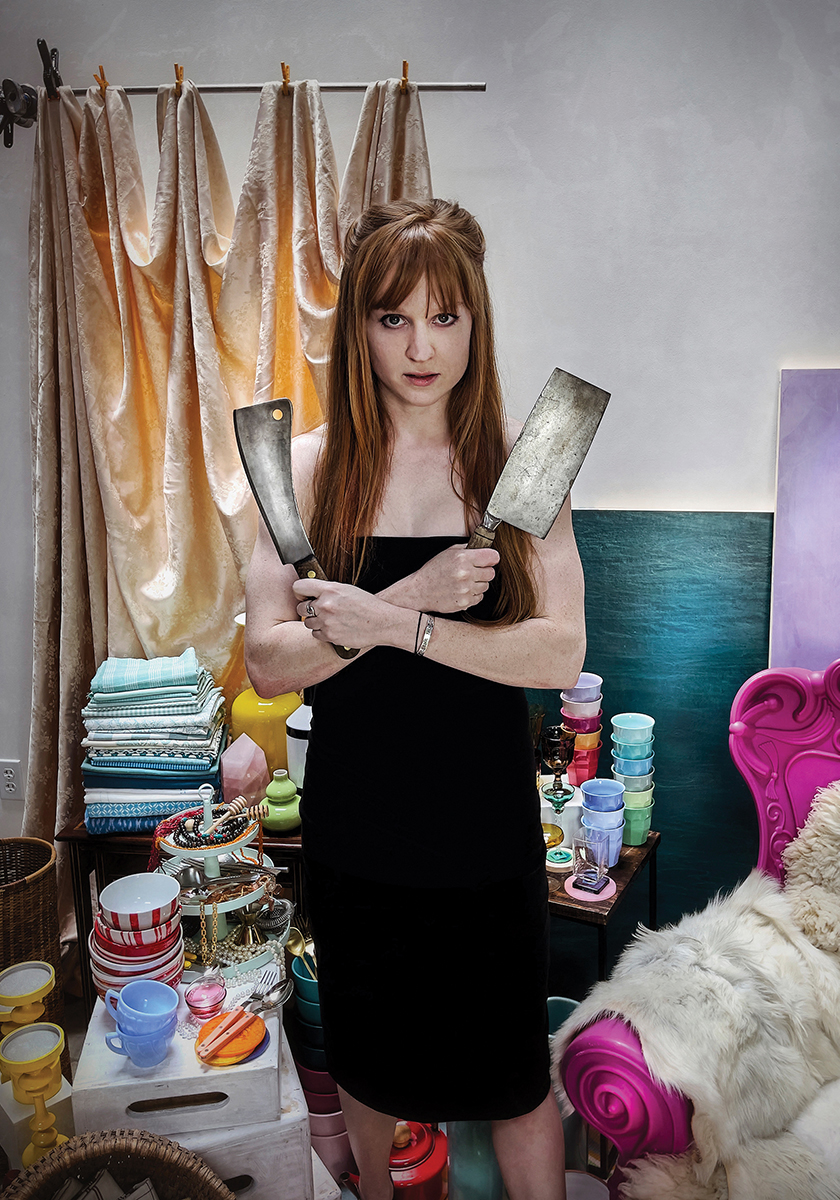
“I’d never really questioned that…things are on plates”
After graduating from SSSAS in 2007, Courtenay arrived at New York University eager to fulfill a childhood dream. “I had known that I wanted to be in New York since I was seven, so it was kind of a no-brainer,” she laughs.
At first, she thought she wanted to be in the art world. “I knew that I wanted to work within a creative industry, but more on the admin side of it,” she says. Being in the city afforded her the opportunity to “fast-track” the process of finding out what she was good at, and what she wanted to do. While in school, she worked at a few art galleries (“It was just not for me”) and interned at Conde Nast, thinking she might find a place in the editorial world.
Courtenay says she was able to weed out different industry options while still in school. “I thought I wanted the art world, but not so much. I thought I wanted the fashion world, [but] not so much,” she said. “But I did get to try it, which was great.”
College also made her grateful for the education she’d received at SSSAS. “I feel like I learned more [academically] from my time there than I did in college,” she admits. “I think the emphasis on writing creativity, and critical thinking…I’m still very thankful for that. It really set up a strong foundation that I still use today, and still fall back on.”
By the time Courtenay got her degree in philosophy and art history in 2011, she had a pretty good idea of what she didn’t want to do for work. But the job she did want was still eluding her. She went on to accept a slate of what she calls “random” jobs, “I was the startup manager for a mixed martial arts gym in Brooklyn,” she says, laughing. “I just did jobs that I thought had value in terms of what they could teach me….but didn’t really have anything to do with what I wanted to do, because I still wasn’t sure what that was.”
During a brief stint of unemployment, Courtenay heard from a friend of a friend in the city. “[She] was like, ‘Oh, my friend works at a prop house, and they’re hiring,’” she says. “I was like, I don’t care what that is. I’ll do it.” Turns out, the house was specifically for tabletop props.
“I had never heard of the industry,” she says. “I mean, I’d worked in magazines before, so I was aware of [props], but I’d never really questioned the fact that, in Bon Appetit, things are on plates in the photo. I didn’t really question where they came from.”
That job at the tabletop prop house in New York changed Courtenay’s entire career trajectory. But that trajectory didn’t come without bumps in the road. After a few years at the prop house, she decided to take the “next logical step,” and become a photo shoot stylist. In the industry, aspiring stylists usually start as stylist assistants, which is what Courtenay did next. But helping style photo shoots didn’t light the same fire in Courtenay that props once had. “Clients can be really difficult,” she says, “and it’s a lot of trying to make impossible things come to life.” Not working with one specific company was stressful (“freelance life really wasn’t for me,” she says) but she wasn’t sure what her next move should be. It turned out to be a literal move—first to Rhode Island, and then across the country.
“I think I felt a little lost,” Courtenay explains. “And I was like, you know what? I’ve got to get out of New York. I need a change of scenery.”
That new scenery would be found in Pawtucket, Rhode Island. Courtenay took a job at a clothing store, All Saints. “I was sort of trying to figure out what exactly the direction was that I wanted to go in.”
Several months later, the retailer transferred Courtenay to a store in Los Angeles. She made her way out west. Then, shortly after, she started searching for a prop house in the area. “That was the largest skill set I had, working with props,” she says. She found a prop house on Craigslist, of all places, the one prop house in the region that specialized in tabletop props. And by chance, they were hiring.
“I think they were as surprised to find me, as I was them,” she laughs.
Courtenay worked with the L.A. house for a year before she felt ready to strike out on her own. “I realized, you know what? I think I can do this better,” she says. “I knew enough about Los Angeles to know that there was a hole in the market here [for tabletop prop houses.]”
But there was one problem—Courtenay didn’t have much in the way of her own collection of props. But then, a fateful connection occurred. “A woman that I knew from New York was a stylist for like, twenty years, and then had her own prop house. She reached out to me and said, ‘Hey, I’ve heard what you’re trying to do. I want to sell you my collection,’” she remembers. “So once that connection was made, it was like, alright. I’ve got to do this.”
A blessing in disguise
Plate & Patina officially opened in January of 2020, and we all know what happened then. “We were open for two months, and then shut right back down,” Courtenay says. But the pandemic-fueled shutdown turned out to be something of a blessing in disguise for Courtenay’s business. “I kind of consider it our soft opening,” she says. The team was able to work out kinks with their point-of-sale software and get a feel for what business operations would look like. When they reopened two months after shutting down, Courtenay says, “I was able to kind of start fresh.”
She says business slowly picked up speed after the company reopened, and has been ramping up ever since. Because of her niche industry, Courtenay relied a lot on word of mouth to spread the word about Plate & Patina. “I can’t really market to just anyone, because there’s a very small circle of people that would use my business,” she explains. “It’s just kind of getting to know the people that are out there in the industry and hoping that they like us enough to tell their friends.”
It’s safe to say—given the success of the business, the growth of her collection, and the fact that Plate & Patina is now the largest tabletop prop warehouse in the Los Angeles area—that people like them. And they have plenty of happy customers and reviewers rave over the “stunning” collection and the friendliness of Courtenay and her team.
These days, when she’s not curating items for the perfect photo shoot, Courtenay spends time with her fiance, Gerry, and is an Orange Theory enthusiast. Oh, and she hasn’t left behind the passion she discovered at SSSAS—she’s gotten back into improv and acting. “I could not get up on a stage and give a speech to save my life,” she laughs. “But give me the chance, and I will jump up and do a weird improv sketch.”
Weird and wonderful. Those might be the best two words to describe Courtney’s pursuits up to this point. Weird, wonderful, and perfectly plated, that is.
The Redhead Project
New York-based Photographer Keith Barraclough is perhaps best known for his portraits of celebrities like Steph Curry, Maggie Gyllenhaal, and the adorable participants of Animal Planet’s annual Puppy Bowl. But he’s also the co-creator of The Redhead Project, a collection of over 500 portraits and accompanying stories of natural-born redheads from around the United States and outside of it. In February 2021, Barraclough and co-creator Kate Lorenz took their project virtual, photographing redheads “wherever they live in the world.”
Barraclough and Lorenz source applicants for the ever-popular project by the letter of their first name. When the pair announced they were looking for redheads with “C” names last spring, Courtenay jumped at the chance to participate. The application process was intense and involved writing an essay and coming up with one’s own idea for a photoshoot.
“I kind of gave them a blurb on my life and told them about the prop house,” she says. “They contacted me and were like, ‘That is weird. We definitely want to see that!‘”
The idea for the series is to photograph the subjects with things that represent their personalities, character traits, or interests. “Of course, I’m surrounded by a ton of my props,” she says. Every photo in the series depicts her surrounded by piles of props, like mixing bowls, dumbbells, salt and pepper shakers, cutting boards, a fake Christmas tree, a bright orange rotary telephone, and more.
“The series is all about getting inside the mind of a redhead,” Courtenay explains. And for this particular redhead that’s being in her warehouse with the things she’s carefully curated to bring visions to life—the photographs certainly nail it.

